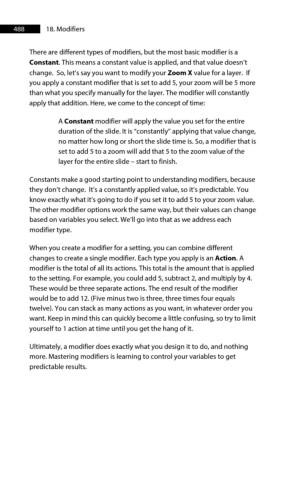Page 488 - ProShow Producer Manual
P. 488
488 18. Modifiers
There are different types of modifiers, but the most basic modifier is a
Constant. This means a constant value is applied, and that value doesn’t
change. So, let’s say you want to modify your Zoom X value for a layer. If
you apply a constant modifier that is set to add 5, your zoom will be 5 more
than what you specify manually for the layer. The modifier will constantly
apply that addition. Here, we come to the concept of time:
A Constant modifier will apply the value you set for the entire
duration of the slide. It is “constantly” applying that value change,
no matter how long or short the slide time is. So, a modifier that is
set to add 5 to a zoom will add that 5 to the zoom value of the
layer for the entire slide – start to finish.
Constants make a good starting point to understanding modifiers, because
they don’t change. It’s a constantly applied value, so it’s predictable. You
know exactly what it’s going to do if you set it to add 5 to your zoom value.
The other modifier options work the same way, but their values can change
based on variables you select. We’ll go into that as we address each
modifier type.
When you create a modifier for a setting, you can combine different
changes to create a single modifier. Each type you apply is an Action. A
modifier is the total of all its actions. This total is the amount that is applied
to the setting. For example, you could add 5, subtract 2, and multiply by 4.
These would be three separate actions. The end result of the modifier
would be to add 12. (Five minus two is three, three times four equals
twelve). You can stack as many actions as you want, in whatever order you
want. Keep in mind this can quickly become a little confusing, so try to limit
yourself to 1 action at time until you get the hang of it.
Ultimately, a modifier does exactly what you design it to do, and nothing
more. Mastering modifiers is learning to control your variables to get
predictable results.

